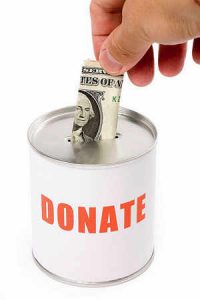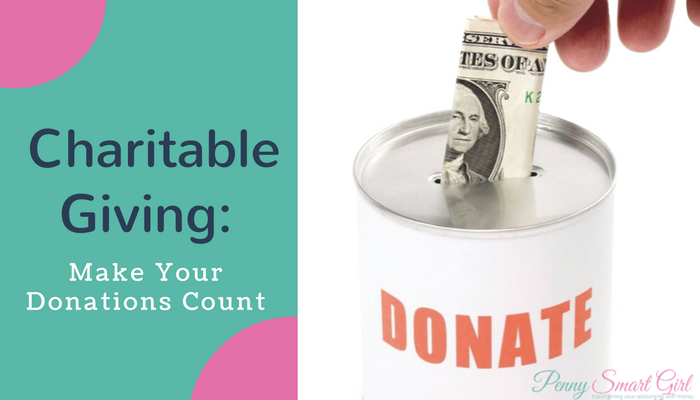Americans have always been a benevolent culture, especially around the holidays. Last year, more than $358 billion was donated to charities, the highest in the 60-year history of Giving USA’s Annual Report on Philanthropy. But unfortunately, scam artists count on this generous nature to bilk thousands of Americans out of millions of dollars every year.
As you explore some of the latest tips, scams, and helpful resources to maximize your giving, remember Giving Tuesday — December 1 this year — an annual reminder to share with those in need.
- Do your research — Determining the effectiveness of a charity can be a difficult task; there are many factors to consider besides the percentage of expenses that goes toward administrative costs, a misconception known as the Overhead Myth. Does the charity offer transparent financials? Are its activities cost-effective? Does it have limited cash reserves? See the FTC’s Signs of a Charity Scam for red flags to avoid.
 Make every dollar count — As much as 40%-90% (or more) of the money given to charities may go to support the nonprofit, fundraisers, or even the executives…not those who actually need the help. Fortunately, help is available to assist in selecting the best charities and nonprofits. Here are just a few of the best resources:
Make every dollar count — As much as 40%-90% (or more) of the money given to charities may go to support the nonprofit, fundraisers, or even the executives…not those who actually need the help. Fortunately, help is available to assist in selecting the best charities and nonprofits. Here are just a few of the best resources:
- Charity Navigator — Analyzes financial health, accountability, and transparency to assign star ratings to around 7,000 nonprofits. Offers an easy-to-use interface to find charities that match your interests.
- Charity Watch— This independent charity watchdog exposes nonprofit abuses and uses specific criteria to stringently evaluate the efficiency, accountability, and governance of 600 nonprofit organizations. They offer A to F ratings and a list of top-rated charities.
- Guide Star — Provides records — including income, spending, mission, and executive salaries — from 1.8 million nonprofits registered with the IRS, but does not provide a qualified rating of each charity.
- BBB Wise Giving Alliance — Offers free reviews of 1,300 national charities; local BBBs have evaluations on an additional 10,000. The organization applies 20 Standards for Charity Accountability; those that meet these standards are designated a “BBB Accredited ”
- GiveWell — Nonprofit that uses specific criteria to determine how much good a given program accomplishes per dollar spent. Rather than rating hundreds of charities, they focus on a handful that best fit their criteria and offer the best opportunities for donors to
- National Association of State Charity Officials (NASCO) — This multi-state resource is available to help donors identify legitimate charities across state
- Government names cancer scams — These phony “charities” conned donors out of $187 million before the government finally shut them down this year: Cancer Fund of America, Breast Cancer Society, and Cancer Support
 The worst offenders — But the government doesn’t catch all of them, and it can take years — and millions of dollars lost — before they are brought to justice. Many scams operate under names that sound like legitimate charities. To avoid getting scammed, refer to SmartAsset.com’s list of The 50 Worst Charities in America, which includes altruistic-sounding operations like Kids Wish Network, Cancer Fund of America, Firefighters Charitable Foundation, Breast Cancer Relief Foundation, and National Veterans Service Fund. For more details on each organization, see the Tampa Bay Times’ list of America’s Worst Charities.
The worst offenders — But the government doesn’t catch all of them, and it can take years — and millions of dollars lost — before they are brought to justice. Many scams operate under names that sound like legitimate charities. To avoid getting scammed, refer to SmartAsset.com’s list of The 50 Worst Charities in America, which includes altruistic-sounding operations like Kids Wish Network, Cancer Fund of America, Firefighters Charitable Foundation, Breast Cancer Relief Foundation, and National Veterans Service Fund. For more details on each organization, see the Tampa Bay Times’ list of America’s Worst Charities.
- Disaster scams — This Causecast article highlights some of the tactics scam artists use when natural disasters strike. Even before Hurricane Katrina hit, dozens of fake charitable Web sites were registered, all claiming to offer Katrina relief. One so-called “charity” in the wake of Hurricane Sandy reaped $600,000, which was used to repay the owners’ personal credit card
- Do Not Call — Telemarketing is a common tactic used by many fraudulent charities to solicit funds. There are more than 222 million numbers listed on the National Do Not Call Registry, but unfortunately, this doesn’t stop telemarketing charity scams since charities are exempt from telemarketing rules. However, once you tell an organization to stop, they must cease calling or risk being subject to a fine. The problem arises that many are owned by the same person or group, so they’re able to call under different names. Just keep telling them you do not want to receive calls, then file a complaint with the Federal Trade Commission (FTC) if they continue to call.
 Taxes — See the IRS’s latest tax tips for year-end gifts to charities, as well as their Donor’s Guide to Vehicle Donation. You can also use the IRS Exempt Organization Select Check Tool to identify whether the organization soliciting your donations is eligible for this tax status, if their application was automatically revoked, or if they filed a Form 990-N.
Taxes — See the IRS’s latest tax tips for year-end gifts to charities, as well as their Donor’s Guide to Vehicle Donation. You can also use the IRS Exempt Organization Select Check Tool to identify whether the organization soliciting your donations is eligible for this tax status, if their application was automatically revoked, or if they filed a Form 990-N.
- Remember..giving your time can mean even more — There are countless ways to help those in need other than giving money. Consider actions like taking food to shut-ins, volunteering at a soup kitchen, shoveling snow for older neighbors or single moms, driving elderly neighbors to appointments, making regular visits to retirees at a senior center, or caring for animals at a local shelter. We can all make a difference!
We hope these tips help you donate wisely this holiday season…and all year long!

